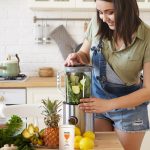A food processor is a versatile kitchen appliance that can help you prepare various dishes, from soups and sauces to doughs and dips. However, there are some things that you should not do with a food processor, such as overloading it, processing hot liquids, or using it for hard foods. Doing so can damage your food processor, affect the quality of your food, or even cause injuries.
Do not overload your food processor
One of the most common mistakes that people make with their food processors is overloading them with too much food. This can cause several problems, such as:
- The food processor may not be able to chop or mix the food evenly, resulting in uneven textures and flavors.
- The food processor may overheat and stop working, or the motor may burn out.
- The food processor may leak or spill the food, creating a mess and wasting food.
To avoid overloading your food processor, you should follow these tips:
- Check the capacity of your food processor and do not exceed it. Most food processors have markings on the bowl or the manual that indicate the maximum amount of food that they can handle.
- Cut the food into smaller pieces before adding them to the food processor. This will help the food processor work more efficiently and prevent clogging or jamming.
- Process the food in batches if you have a large amount of food to process. You can transfer the processed food to another bowl and then add more food to the food processor.
Do not process hot liquids in your food processor
Another thing that you should not do with your food processor is processing hot liquids, such as soups, broths, or sauces. This can be dangerous for several reasons, such as:
- The hot liquid may expand and create pressure inside the food processor, causing the lid to pop off and the liquid to splash out. This can burn you or damage your kitchen counter or appliances.
- The hot liquid may warp or crack the plastic parts of the food processor, such as the bowl, the lid, or the blade. This can affect the performance of the food processor or make it unsafe to use.
- The hot liquid may contaminate the food processor with bacteria or mold, especially if you do not clean it properly after use. This can affect the taste and safety of your food.
To avoid processing hot liquids in your food processor, you should follow these tips:
- Wait for the liquid to cool down before adding it to the food processor. You can use a thermometer to check the temperature of the liquid or touch it with your finger to see if it is warm or cold.
- Use a blender instead of a food processor for hot liquids. A blender is designed to handle hot liquids better than a food processor, as it has a vented lid that allows the steam to escape and a glass or metal jar that can withstand high temperatures.
- If you have to use a food processor for hot liquids, do it carefully and in small amounts. You can cover the lid with a kitchen towel to prevent splashing and pulse the food processor instead of running it continuously.
Do not use your food processor for hard foods
A third thing that you should not do with your food processor is using it for hard foods, such as ice, coffee beans, nuts, or bones. This can damage your food processor, as well as your food, in several ways, such as:
- The hard food may dull or break the blade of the food processor, making it less effective or unsafe to use.
- The hard food may scratch or dent the bowl of the food processor, affecting its appearance and durability.
- The hard food may not be processed properly by the food processor, resulting in chunks or shards that can hurt your teeth or throat.
To avoid using your food processor for hard foods, you should follow these tips:
- Use the appropriate tool for the hard food that you want to process. For example, you can use an ice crusher for ice, a coffee grinder for coffee beans, a nut chopper for nuts, or a meat grinder for bones.
- If you have to use a food processor for hard foods, do it sparingly and with caution. You can chop the hard food into smaller pieces before adding them to the food processor and use the pulse function to control the speed and power of the blade.
- Check the manual of your food processor to see what kinds of foods it can and cannot handle. Some food processors may have special attachments or settings that can handle hard foods better than others.
Conclusion
A food processor is a useful kitchen appliance that can make your cooking easier and faster. However, you should not do some things with a food processor, such as overloading it, processing hot liquids, or using it for hard foods. These can harm your food processor, your food, or yourself. By following the tips in this article, you can avoid these mistakes and use your food processor safely and effectively.



